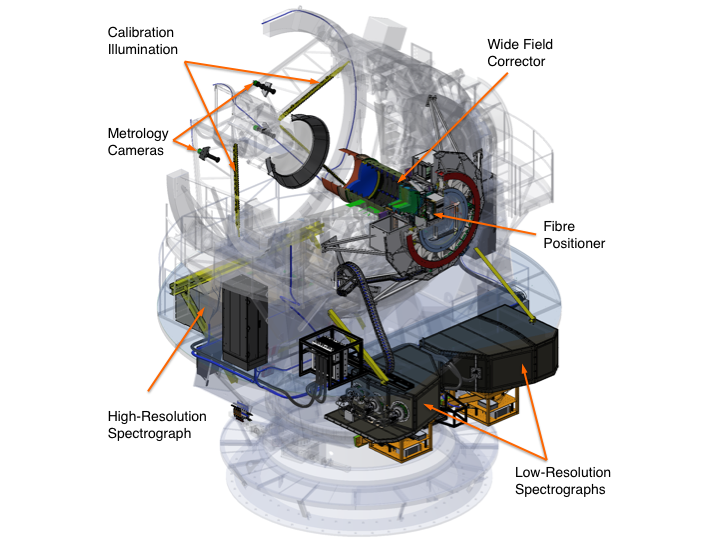Southern spectra galore: 4MOST consortium presents its facility to the astronomical community
With the publication of 13 “White papers,” the 4MOST consortium has presented its unique survey facility to the scientific community. The 4MOST spectrograph is slated to be installed on ESO’s VISTA telescope at Paranal Observatory in Chile in 2022. The publications detail the instrument’s capabilities as well as the ten main survey programs that are currently under development.

Layout of the different subsystems of 4MOST on the VISTA telescope.
The 4-metre Multi-Object Spectroscopic Telescope (4MOST) is slated to start science operations at Paranal Observatory in Chile in 2022. The instrument will be mounted on ESO’s VISTA telescope. It will provide a particularly large field of view of 4.2 square degrees, which is about twenty times the apparent size in square degrees of the Moon on the night sky. 4MOST will take 2400 spectra of astronomical objects every night. For every spectrum, an optical fibre will be positioned at the right spot within the telescope’s focal plane with high accuracy. This mode of observation allows for multiple observations to be carried out simultaneously, making 4MOST a highly efficient instrument suitable for a variety of different scientific goals. All in all, 4MOST expects to take tens of millions of spectra in its first five-year period of operations.
A unique opportunity
Ten surveys targeting astronomical objects as diverse as quasars and stars within our own Milky Way have already been defined by the 4MOST consortium. But from this summer onwards, even astronomers who are not part of the consortium will have the opportunity to submit their own surveys. 4MOST principal investigator (PI) Roelof de Jong (Leibniz Institute for Astrophysics Potsdam, AIP) says: “This will be a singular opportunity for the astronomical community to apply to use the facility during its first five years of observation.”
But in order to take advantage of this opportunity, astronomers will need to know the specifics of what 4MOST can do – and since surveys should not duplicate each other’s efforts, they will also need to know what is already planned. This is why the 4MOST consortium has now published a series of 13 articles in ESO’s in-house publication “The Messenger,” giving the astronomical community all the information it needs to make use of this unique opportunity.
Collaborative astronomy
The instrument is currently under construction by a consortium consisting of 330 scientists and engineers from 15 institutes in Germany, the UK, France, Sweden, Switzerland, Australia, and the Netherlands, led by AIP. The Max Planck Institute for Astronomy (MPIA) will provide the instrument’s control electronics; furthermore, MPIA researcher Maria Bergemann co-leads the 4MOST high-resolution survey of stars in the Milky Way disk and bulge, aiming at a better understanding of the history and evolution of our home galaxy. Additional galactic surveys are prepared by astronomers of Heidelberg University’s Zentrum für Astronomie (ZAH) as part of the Collaborative Research Center SFB 881 “The Milky Way System,” in which MPIA is also a partner institute.
4MOST also sets standards for Open Science: All data obtained in its surveys will be public, and will be available for download in ESO’s science archive facility.
Background information
4MOST is an international consortium consisting of the Leibniz Institut für Astrophysik Potsdam (PI institute), Australian Astronomical Optics (AAO), the Centre de Recherche Astrophysique de Lyon (CRAL), the École polytechnique fédérale de Lausanne (EPFL), the European Southern Observatory (ESO), Lunds Universitet (LU) and Lund Observatory, the Max Planck Institute for Astronomy (MPIA) in Heidelberg, the Max Planck Institute for Extraterrestrial Physics (MPE) in Garching, Nederlandes Onderzoekschool voor Astronomie (NOVA), the Kapteyn Astronomical Institute at Rijksuniversiteit Groningen (RuG), the Institute for Astronomy (IoA) at the University of Cambridge, Hamburger Sternwarte at Universität Hamburg (UHH), the Zentrum für Astronomie (ZAH) at Heidelberg University, the International Centre for Radio Astronomy Research (ICRAR) at the University of Western Australia and the Department of Physics and Astronomy at Uppsala Universitet (UU).
